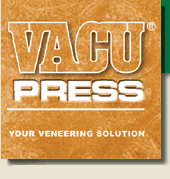adam e

Posts: 9
Joined: 2012-10-01
Location: santa fe, nm
 User Profile User Profile |
Hi Don,
Lurking curious minds should never be left hanging.
Here is my correspondence with Jay White at Oakwood.
Thoughts on moving forward?
Jay,
I have a problem with a veneered table I did about three years ago. I have been doing vacuum-bag veneering for over ten years and it is something I've never experienced. Darryl at Vac-u-Press suggested I talk to you.
Rather than re-explaining the situation I am attaching the link to the V-u-P forum where I posted the problem and got some feedback. I am at a loss as to what caused the problem and what to do about it.
When you get a moment, please take a look and let me know what you think.
Thank you very much,
Adam Eisman
There are a couple of issues that can better shed light onto what is possibly going on here. Acer species like Maple and Sycamore have a tendency to move at a much greater rate with changes in humidity and temperature than most all other species, surface failures like this are clearly the result of movement in the veneer. The way we know this is the cracks and ridging are linear with the grain. If it were a bonding issue of the veneer to the paper, the result would be more in the order of bubbles both linear and perpendicular with the grain, lifting the veneer face off the paper. What actually is happening is the veneer is expanding and contracting faster then the finish can, and before you know it, a failure of the finish itself. Also if it were a bond issue it would have shown up much sooner, generally as soon as the finish cured after application. The fact that it has gone through basically 6 heating and cooling cycles then failed is another indicator of the finish finally giving up. If it were caught sooner it could have been possible to sand and refinish before tearing occurred. We have found over the years that finishing veneered surfaces is not a one size fits all situation when it comes to selecting finishes. We have also found with Maple/Sycamore a 2 part polyurethane tolerate changes in environment much better than conversion finishes. The other side of this is the environment itself and the importance of maintaining temperate conditions. While it is difficult to explain to our clients, they must understand that what there are getting in the way of furniture, cabinets, panels ect are alive, alive in the sense that they will react with their environment, and if shifts in climate are not kept within reasonable percentages of change, failure is imminent. I am attaching a copy of the AWI info sheet regarding temperature and humidity and its effect on millwork.
I hope you find this information helpful.
Jay White
Oakwood Veneer Co.
Jay,
Thank you so much for your in-depth response.
A question that comes to mind though is this: would not the fact of the veneer being quarter-sliced be relevant? Virtually all of the movement would be radial as opposed to tangential, which would mean that a differential movement condition between the wood and the paper would not exist.
I just don't know, and of course am extremely uncomfortable taking any step to remedy the problem.
I can't even figure what the next step would be.
Thanks again,
Adam Eisman
Jay,
To clarify:
As radial movement (opposed to tangential) is negligible, movement of the quarter-slice across the paper would be too.
I know you know this, I just want to assure you I understand the issues around movement.
Thanks again,
AE
Conventional wisdom in understanding how wood moves makes that true however were talking about a very thin material that is moving laterally, if this were flat cut the linear cracks would be 100 times worse.
Jay, Don Stephan at the Vac-u-press forum asked where things stand with the table. Are you ok with my posting this exchange in that thread? It is helpful stuff for anyone, and I'm still trying to determine what the next step is.
Thanks,
Adam
Hi Adam,
Sure, I see no reason not to share this. The one other addition I would add is that its not that certain finishes are "not" appropriate or "bad" products its that there are conditions that exist that can compromise even the best materials given the number of pieces of the puzzle that exist when dealing with wood and wood veneering. Many things have to be taken into account, and as fabricators we sometimes have to juggle our techniques to try to cover all bases. Because this is clear coated you might be able to sand this out and re shoot it. It all depends on what you find after sanding of course. The trick obviously is to avoid sand throughs.
Jay
|






